The Albion R. Hodgdon Herbarium (NHA) is an important resource for the support of research and teaching at the University of New Hampshire, as well as a source of information for scientists at other colleges and universities and federal, state, and private agencies such as the U.S. Fish & Wildlife Service, U.S.D.A. Forest Service, the N.H. Natural Heritage Bureau, and The Nature Conservancy. The herbarium contains a combination of historic and recently collected specimens, including a number of nomenclatural type specimens and voucher specimens supporting taxonomic, molecular systematic, ecological, and biogeographic research. NHA provides a wealth of biogeographic and ecological habitat data in its specimen labels, and the plants themselves are a valuable source of information on species morphology, variability, and genetics. The collections have historical value in documenting changes in the flora of the region, in features such as occurrence, abundance, and flowering time. Our specimens also serve as an important reference in the identification of plant specimens, including poisonous plants, invasive taxa, and species of conservation concern in the state and region. NHA has been cited in over 680 scientific publications!
Below are examples of ongoing research at NHA. Additional research activities can be found on the Department of Biological Sciences home page and on individual faculty pages.
Inventorying Rare & Endangered Species
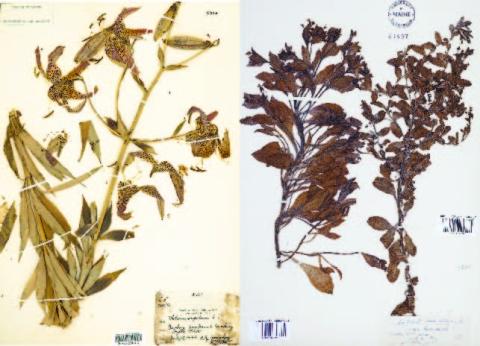
Species absent from the herbarium or have not been recently collected.
Over the past 15 years, the staff and students at Hodgdon Herbarium have been systematically inventorying its collection of vascular plants and algae to inform our holdings and assess how well they represent the plant diversity of New Hampshire. For his capstone project, Biology senior Uriah Upchurch documented the UNH’s collection of extirpated and historically present species. His work will inform future collection and research efforts at the Hodgdon Herbarium by focusing on under-collected counties and species and targeted acquisition of specimens from other herbaria. See here for a written and data-based summary of Uriah's work.
Documenting the flora of Hubbard Brook

DBS senior Liv Thrower with a Hubbard Brook specimen documenting a new species for the site.
The Hubbard Brook Experimental Forest is a protected 7,800-acre plot of forest in the White Mountains National Forest of New Hampshire. As the site of a long-term ecological study, researchers at Hubbard Brook aim to better understand the changes a forest ecosystem undergoes due to anthropomorphic stressors such as pollution and climate change, as well as natural changes. For her capstone project, UNH DBS senior Liv Thrower is working with herbarium specimens contributed by botanist JoAnn Hoy, to better document the flora of Hubbard Brook and update the site’s floristic index, including 99 new species to date. This work will increase awareness of plants living within the experimental forest and help researchers document new and emerging species at the site. For more information on Hubbard Brook, check out https://hubbardbrook.org. Digital images of these specimens will be deposited on the Consortium for Northeastern Herbaria portal at https://neherbaria.org.
Documenting the Flora of Asia
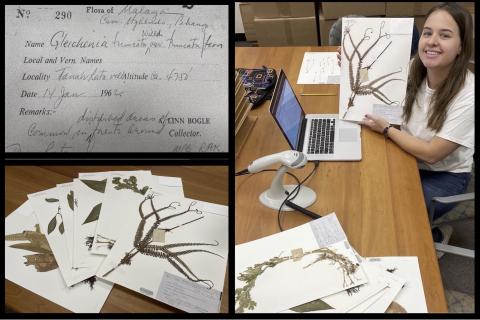
Undergraduate curator Mariah Rietzel processes a specimen collected by Dr. Linn Bogel in Malaysia.
Asia constitutes ~30% of the world’s landmass and an equal or greater percentage of global plant diversity. Despite this, digital specimen records from Asia are significantly underrepresented, limiting knowledge about on the flora of the continent. As part of the National Science Foundation funded collaborative research grant “Collaborative Research: Bringing Asia to digital life: mobilizing underrepresented Asian herbarium collections in the US to propel biodiversity discovery” (NSF- 2101884), the undergraduate curators at the Hodgdon Herbarium are imaging, databasing, and georeferencing its nearly 2000 Asian specimens. These include approximately 200 specimens collected by UNH’s Dr. Linn Bogle on a collection trip to North Borneo, India, and Taiwan in the 1960s. The Hodgdon Herbarium specimens from Asia will be publicly available online in the forthcoming All Asia portal.
Preserving Extinct Plant Species
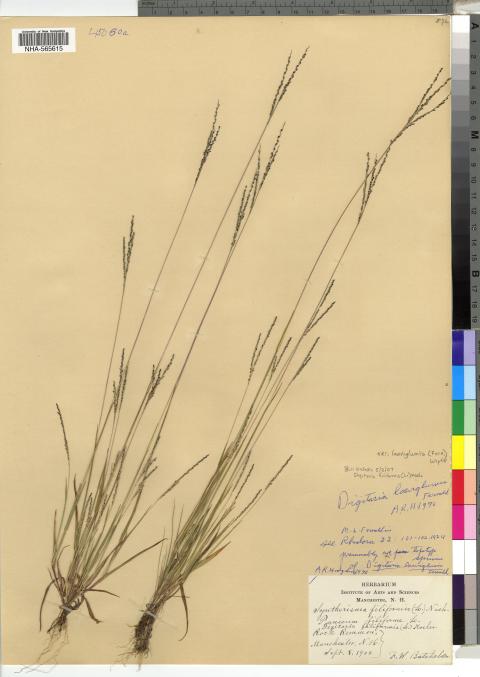
A specimen of Digitaria laeviglumis.
The Hodgdon Herbarium documents New Hampshire’s flora over time and space and holds invaluable records of endangered and extinct species. For example, the Hodgdon Herbarium has three of the only ten collections of the Digitaria laeviglumis, a grass endemic to Rimmon Rock Park in Manchester, NH. Working with a team of botanists from the NH Natural Heritage Bureau, West Virginia University, and Instituto de Ecología, A.C. in Mexico, NHA Collections Manager Erin Sigel investigated whether Digitaria laeviglumis has been rediscovered in Mexico. Using a combination of molecular and morphological data, the scientists confirmed that the NH and Mexican plants belong to two distinct species, and that Digitaria laeviglumis is indeed extinct.
Tracking the Population Dynamics of Invasive Plants
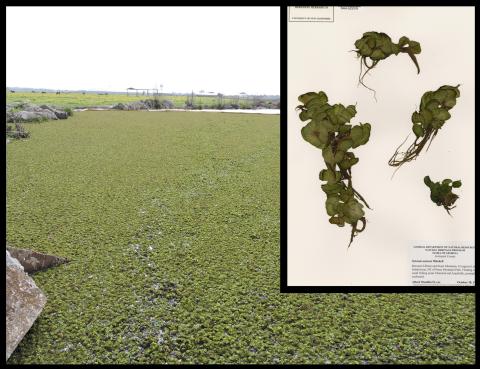
Salvinia molesta invading a lake (image: lsuagcenter.org)
Invasive species threaten biodiversity, impact crops, restructure ecosystems, promote disease, and damage infrastructure, costing the US $120 billion annually. By adapting modern genomic techniques to sequence fragmented DNA from herbarium specimens of different ages, Dr. Erin Sigel, NHA Collection Manager, and her colleagues at the NSF-funded Consortium for Plant Invasion Genomics are constructing time series genomic datasets to examing the effects of multiple colonization events, gene flow, and adaptation on the population dynamics of invasive plants over time. The Hodgdon Herbarium is a key participant in this collaboration, providing genetic material from specimens of white clover (Trifolium repens), the invasive aquatic fern giant salvinia (Salvinia molesta), and Russian thistle (Salsola tragus), and serving as a repository of contemporary collections.
Detecting cryptic fern species in Hawaii
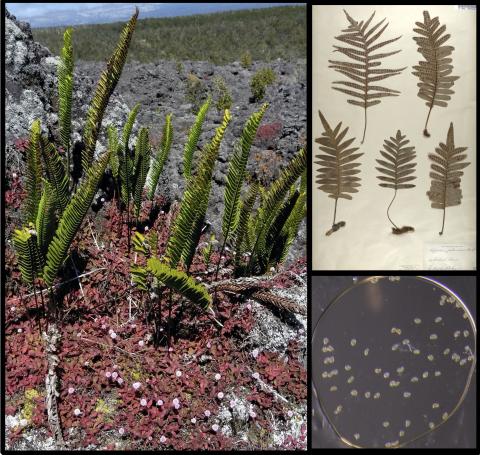
Hawaii is known as a biodiversity hotspot with many species found nowhere else in the world. Among these is Polypodium pellucidum an endemic Hawaiian fern that is morphologically variable and grows on lava flows, as an epiphyte, or in the forest understory. In collaboration with Jonas Mendez Reneau at the University of Louisiana, NHA Collections Assistant Julia Hobbie is using fern spore size data from herbarium specimens to determine if different morphological and ecological variants of P. pellucidum have different ploidies, or numbers of chromosomes, and should be considered different species. This work will inform the conservation of P. pellucidum across the Hawaiian Islands.
Studying the changing flora of mitigated wetlands

Wetland mitigation, the creation of wetlands in former uplands to compensate for wetland damages, is commonplace across the United States, but the long-term successional patterns of plant communities following mitigation is understudied. Master’s student Grant McKown and Dr. Gregg Moore conducted a floral inventory of the thirty-five year old Quarry Pond mitigated wetland in Portsmouth, NH. Building on prior floral surveys of the site by Dr. Garrett Crow, they have constructed a long-term dataset to document changes in wetland plant composition. Specimens collected over the past thirty-five years have been deposited at NHA to document the wetland flora of NH and train future wetland researchers at UNH.
Predicting the Spread of an Invasive Alga

Dasysiphonia japonica localities and herbarium specimen (image: B. O'Brien)
The red alga Dasysiphonia japonica was introduced to New England in 2007, and has since become one of the most abundant seaweeds in this coastal ecosystem by outcompeting native species and forming large monocultures across the seafloor. Using locality information obtained from herbarium records, graduate student Brandon O’Brien and Dr. Chris Neefus are mapping the current range of D. japonica in New England. By combining this with data on environmental ocean conditions, they are building statistical models to predict the future distribution of this D. japonica along the Atlantic coast and identify other regions across the world that are vulnerable to invasion.
Developing Molecular Markers for Algae

Algae specimens used to develop target-capture probes.
Next generation sequencing techniques offer new ways to capture thousands of gene sequences from degraded herbarium specimens, allowing scientist look at genetic changes is plants across broad temporal and special scales. Using specimens from the Hodgdon Herbarium, Collections Manager Erin Sigel, Dr. Chris Neefus, and Dr. Gordon Burleigh of the University of Florida are developing and testing target-capture probes for red and green algae. Ultimately, these probes will be used to capture approximately 300 genes from specimens belonging to these understudied groups that can be used to reassess their evolutionary relationships and populations genetics.